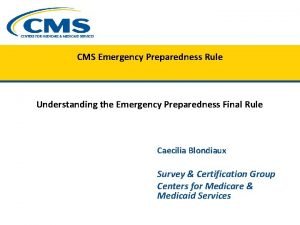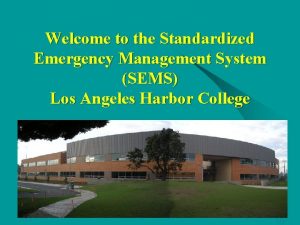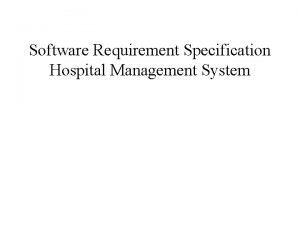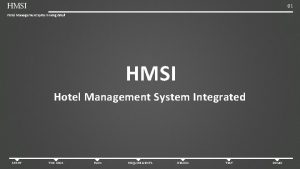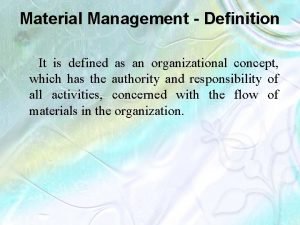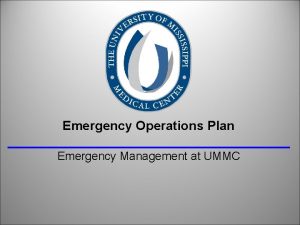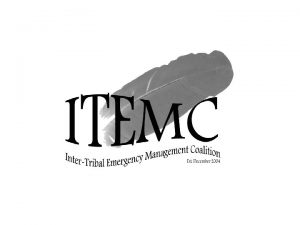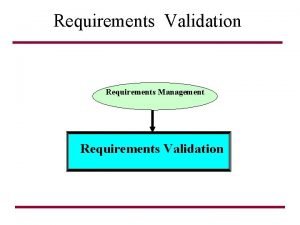PURPOSE AND SYSTEM Emergency Management Requirements Defined in









- Slides: 9

PURPOSE AND SYSTEM

Emergency Management Requirements Defined in • DOE Order 151. 1, Comprehensive Emergency Management System and further interpreted in the DOE Guide 151. 1 series

Emergency Management System A system created for the development, coordination, and direction of an emergency. It includes • Planning • Preparedness • Response levels o Strategic—Emergency Operations Center (EOC)/Incident Command (IC) o Tactical—Field response o Task—Field response • Recovery—Support agencies • Readiness assurance

Purpose of Emergency Management and Response Programs To protect • Site/facility personnel and the public • Site/facility property • The environment

Integrated Safety Management Ensures • Emergency Management is addressed by the safety management program to ensure the safe operation of a facility/site or activity • Consistency across the complex through a common understanding of emergencies and the expected DOE response at all organizational levels, including the local worker and facility/site or activity level • Continuous improvement. Readiness assurance provides the framework and associated mechanisms to assure that planning and resources are adequate and sufficiently maintained, exercised, and evaluated, and that appropriate, timely improvements are made in response to needs identified

Integrated Safety Management System Core Functions · · · Feedback/Improvement Event Critiques Drill/Exercise Reports Self-assessment DOE Oversight Lessons Learned Perform Work · Emergency Response · Drills · Exercises · · · Define Scope of Work Identify Facilities Identify Hazards Allocate Resources Assign Responsibilities Set Expectations Emergency Management Program · · · Analyze Hazards · Perform Consequence Analyses · Conduct Dispersion Estimates Develop/Implement Controls Facilities and Equipment Emergency Action Levels Predetermined Protective Actions Notification and Warning Systems Training

National Incident Management System (NIMS) Background • In response to September 11, 2001 (9 -11), the Homeland Security Presidential Directive 5 (HSPD-5) was issued on February 28, 2003 • Federal, state, and local agencies were encouraged to use the same emergency management system (i. e. , terminology and training) • NIMS provides a national framework for preparing, preventing, responding to, and recovering from domestic incidents that includes o Command management o Preparedness o Resource management o Communications and information management o Supporting technologies o Ongoing management and maintenance

DOE/NNSA Emergency Management and NIMS Requires • Compliance with the requirements of the National Response Framework (NRF) and NIMS o Incorporating NIMS concepts, principles, and terminology into existing Emergency Plans and standard operating procedures (SOPs) o Meeting training program requirements o Providing authority and responsibility for the Emergency Director to perform required functions, including • initial activation of onsite response assets • notification of offsite authorities • requests for offsite assistance • Control and coordination at an event/incident scene that must be consistent with NIMS’ Incident Command System, which integrates federal, tribal, state, and local agencies and organizations that provide onsite response services

DOE/NNSA Emergency Management and NIMS (cont. ) Where applicable, pre-designate a DOE/NNSA employee as the • On-Scene Coordinator when DOE/NNSA is the lead agency for Federal responses under the National Contingency Plan or its replacement • Senior Federal Official when DOE/NNSA is the Coordinating Agency under the Nuclear/Radiological Incident Annex of the National Response Framework or its replacement • Senior Energy Official to coordinate Departmental activities under appropriate Federal plans
 Is a collection of well defined objects
Is a collection of well defined objects Cms emergency preparedness rule
Cms emergency preparedness rule Middle level of sems
Middle level of sems Erd diagram of hospital management system
Erd diagram of hospital management system Sequence diagram for gym management system
Sequence diagram for gym management system Hotel management system architecture diagram
Hotel management system architecture diagram Mathematical system examples
Mathematical system examples Four basic needs of material management
Four basic needs of material management Definition of material management
Definition of material management Operations definition
Operations definition

